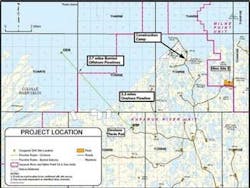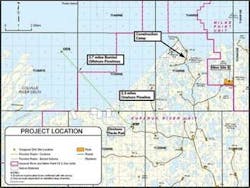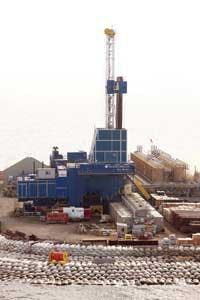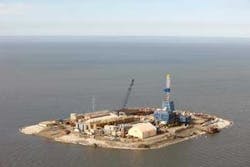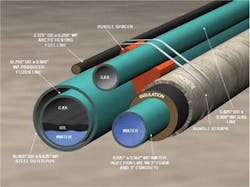Oooguruk project offshore Alaska
J.D. Hall, Pioneer Natural Resources Alaska Inc.
The Oooguruk project is in the near-shore of Alaska’s Beaufort Sea and consists of a 6-acre gravel drill site approximately 5 mi (8 km) offshore in 4.5 ft (1.4 m) of water. The site is connected to an onshore facility by a flowline system consisting of a 5.7-mi (9.2-km) subsea buried flowline bundle which transitions onshore to a 2.3-mi (3.7-km) traditional North Slope aboveground flowline support system.
Developing the Oooguruk field in the offshore arctic was complicated by several factors that affected design, construction, and operations. The primary challenges can be attributed to the arctic conditions that exist most of the year and the seasonal constraints on transportation and logistics. After considering the weather windows and seasonal restrictions, Pioneer developed and implemented a construction plan. The project was sanctioned in early 2006 and construction of the gravel island drill site began immediately, and was followed by facility construction and commissioning. Development drilling started in December 2007; production began in June 2008. Pioneer is the first independent to initiate new field operations on the North Slope and set a new precedent for North Slope offshore development by bringing Oooguruk online in five years.
Pioneer anticipates peak gross production in 2010 of 15,000 to 20,000 b/d of oil from approximately 40 development wells (approximately half production wells and half injection wells). These wells are scheduled to drill over the next three years. The gross potential from these base development wells is 70-90 MMboe, before expansion opportunities. The field life is expected to be 25 to 30 years.
Pioneer Natural Resources operates Oooguruk with a 70% working interest. Eni owns the remaining 30%.
Development plan
The project consists of three major components: an offshore drill site (ODS); an onshore interconnect and production support facility (OTP); and a system of flowlines, power cables, and communications cables connecting the onshore and offshore facilities. Three phase production is delivered through an interconnect to existing infrastructure at the Kuparuk River Unit (KRU) drill site DS-3H operated by ConocoPhillips. The facilities were designed, constructed, and installed to survive in and to protect the environment. The project is near the mouths of the Colville River Delta and Kalubik Creek, which create seasonal phenomenon that need consideration. Additionally, the area is important to the local communities for subsistence activities such as hunting, whaling, and fishing.
Construction challenges
The weather cycle in Alaska creates opportunities and challenges throughout the year. The North Slope primarily consists of wetlands and tundra that can be damaged easily. The windows of opportunity were narrower for Oooguruk than a typical North Slope project since a large portion of the project is offshore. Roads on the North Slope allow continual access to the onshore facility; however, the remainder of the project is subjected to seasonal transportation constraints.
A majority of the construction needed to be scheduled during the ice road season. Ice road construction times vary each year and the processes for onshore and offshore ice roads are different. Several key activities, including the gravel haul for island construction, offshore flowline trenching and installation, and heavy haul transport of the modules and drilling rig to the drill site, required the sea ice be completely grounded to the seafloor, which further reduced the window for offshore construction.
Pioneer originally considered constructing the island, installing the flowlines, installing the modules, and transporting the rig during a single ice road season in 2007. However, after some engineering, it was determined the activities should be split into two ice road seasons. This decision was driven primarily by the desire to work the drill site gravel and then allow the island to settle into the seafloor for a summer. Thus, the drill site construction activities were accelerated to the 2006 ice road season.
Offshore drill site
Ice road construction began in January 2006 and gravel mining operations started in February. The gravel drill site has approximately 6 acres of working area and an elevation of approximately 13 ft (4 m) above mean sea level with slope protection provided by gravel bags. The site has dock facilities for re-supply in the summer and a ramp for re-supply in the winter. The island is designed to survive the area’s environmental conditions.
The gravel was sourced from an existing mine within KRU. Approximately 425,000 cu yd (324,935 cu m) of gravel was needed to construct the drill site. An additional 30,000 cu yd (22,937 cu m) went to construct the onshore pad (OTP). Ice road construction continued in parallel with the mining. The process of hauling gravel from the mine site to the drill site could begin once a sufficient supply of gravel had been accumulated, wick drains (to accelerate gravel settlement into the seabed) had been installed and ice grounding was completed. Sections of ice were removed at the site and gravel dumping started in March 2006. Over 400,000 mi (644,000 km) were traveled (20,000 truck loads) in the mining and hauling operations. The drill site was completed the last week in April 2006.
null
Production facilities
Production facilities on the offshore drill site consist of wellbay modules and truckable production modules. The production modules contain two multi-phase meters for well testing, a chemical injection module, and pig launchers and receivers. Truckable modules were installed for electrical power distribution, variable speed drives for ESPs, control system and operator interface room, and communications systems (voice, data, and control). Production operations support utilities for the drill site consist of backup power generation, emergency escape equipment, contingency oil spill equipment, water and diesel storage, personnel quarters (76 man capacity), water treating facilities, sewage treating facilities, warehouse, maintenance shop, utility and instrument air supply, nitrogen generator, incinerator, weather observation center, and helideck.
Wellbays
Wells are arranged in two rows on opposite sides of wellbay modules. These truckable modules are a first for the North Slope. Wells are spaced on 7-ft (2.1-m) centers. The wellbay modules were designed to sit on concrete blocks near the gravel with allowances for a cantilevered drilling or workover rig to approach each side to access a well row. The bottom 2 ft (0.6 m) of the wellbay modules have sealed containment to prevent discharges from reaching the gravel. Flowlines, injection lines (water and gas), and gas lift lines are in the wellbays and terminate on manifolds running down the middle of the wellbay module between the well rows. The wellbay modules manifold system has automated valves to place wells into the test or production headers. Switching an injection well between water and gas is manual. Even though the development concept only required 39 well slots, 48 well slots were installed.
Rig support complex
The rig support complex serves four main purposes. First, it provides the drilling fluid services including grind and inject facilities, mud mixing, and cement mixing. Second, it stores all of the required fluids including water based mud, oil based mud, diesel, potable water, sea water, fire water, waste slurry, and well flow-back fluids. The rig support complex also includes bulk cement storage. Lastly, it includes all of the piping and equipment required to transfer fluids and cuttings during drilling.
Drilling rig
Pioneer requested proposals in 2005 for a “fit for purpose” drilling rig that could accomplish Oooguruk’s challenging three-year extended reach drilling (ERD) program. Typical North Slope drilling rigs are not designed for Oooguruk’s wellbay concept, so it was unlikely an existing rig would work. Pioneer selected Nabors AlaskaRig 19E and began extensive modifications in order to meet the project’s requirements.
Not only did the rig require significant mechanical modifications including a new derrick, top drive, and moving system, but it also needed to go from DC to AC. Rig modifications were done in Deadhorse, Alaska, during the summer, fall, and winter of 2006 and into 2007. The drilling rig was moved from Deadhorse onto the drill site in April 2007, and renamedRig 19AC.
The development drilling rig uses a moving system to cantilever over the wellbays and to move down each well row. The drilling rig and moving system are designed to cut moving times down to a few hours. The arrangement requires that the rig access both sides of the wellbays. When the rig is on one side, the space on the opposite side can be temporary storage for consumables. Through this arrangement the well layout footprint could be minimized to allow more drill site space for other activities and equipment. The rig is an arctic-capable unit with an enclosed tubular handling facility.
Onshore tie-in and production support
Production facilities onshore consist of a production, power and control, and operations support modules. The onshore production modules contain a two-phase production separator, production heaters, two multi-phase production meters, injection gas compressors, chemical injection package, diesel storage, diesel shipping pumps, and pig launchers and receivers. The power generation facilities include three 5.5 MW gas-fired turbines to power all the onshore and offshore production and drilling facilities. Waste heat from the turbines can heat the medium for the production heaters. Electrical power distribution, control system and operator interface room, and communications system (voice, data, and control) are in truckable modules. Production operations support utilities for the onshore pad consist of backup power generation, warehouse and maintenance shop, utility and instrument air supply, nitrogen generator, and helicopter landing deck and hangar.
Flowlines, power and communication cables
Offshore flowline design and construction was one of the challenging aspects of the project. Buried flowline bundles had been installed in the arctic, but none as complex as Oooguruk’s. The flowlines were installed in winter 2007.
A 5.7-mi (9.2-km) buried subsea flowline bundle from the drill site to shore contains a 12.75-in. (32-cm) multi-phase production flowline, an 8.625-in. (22-cm) water injection line, a 6.625-in. (17-cm) gas injection line, a 2.375-in. (6-cm) diesel/base oil transfer line, and a fiber optic communications cable. Three power cables and another fiber optic communications cable are in a separate trench.
Pipe-in-pipe construction for the offshore production flowline was used primarily for leak detection purposes, insulation, and also to provide secondary containment in the event of a leak. Leak detection is done by creating and monitoring a vacuum in the annulus between the pipes.
As the flowlines and cables transition onshore, they separate and are installed on 2.3 mi (3.7 km) of vertical support members (VSMs) until they arrive at the onshore production and tie-in facility (OTP). The water injection line continues for another 1.25 mi (2 km) past DS-3H on existing VSMs to its tie-in location near DS-3A.
Module fabrication
Fabrication contracts were awarded in early 2006. Pioneer selected truckable modular construction for most of the facilities in order to minimize the installation and hook up effort on the North Slope and to avoid the schedule constraints of a sea lift. In most cases, truckable modules were connected to form a larger module after installation. Even long pipe racks with piping and cable trays were built to be trucked, and then connected on the North Slope. Over 100 modules were built. Drill site modules had to be transported across the ice road, so their timeliness was critical. As such, Pioneer elected to have most of the offshore modules fabricated in Alaska in order to maximize shop time and minimize transportation time. All of the offshore modules were in place by the end of the 2007 ice road season.
Drilling program
Production is anticipated from two zones. The Nuiqsut and Kuparuk C Sand reservoirs are expected to produce 22° API and 25° API oil, respectively, with most of the production from the Nuiqsut. Both require line drive waterfloods for maximum recovery. Under favorable economics, Nuiqsut may be injected periodically with gas to improve recovery. Injection volumes are expected to be similar to production voidage volumes. Recovery will be enhanced further by installing ESPs in each production well.
Pioneer’s base plan projects five wells - three producers and two injectors - will be needed for recovery of the Kuparuk reserves. A total of 33 wells - 18 producers and 15 injectors - will be drilled to recover the Nuiqsut reserves. The depletion plan for both reservoirs will require long horizontal wells with lateral lengths from 5,000 to 9,000 ft (914-2,743 m) and total measured depths between 15,000 and 23,000 ft (4,572-7,010 m). Since the drill site needs to be self sufficient due to isolation during certain times of the year, a Class 1/Class 2 disposal well also was drilled.
Rotary steerable technology is critical in drilling the wells. Anti-collision and close approach methodology and best practices also are important factors because of the 7-ft (2.1 m) well centers. Batch drilling of surface holes using electromagnetic and magnetic ranging technologies is required to ensure no well collision issues.
The next step
Pioneer met all seasonal constraints and was able to substantially maintain the project schedule. While the construction effort on Oooguruk was extremely complex and challenging, the three-year drilling program will be equally challenging. Proper execution of the drilling program is the next crucial step to ensure the continued success of the Oooguruk project.
About the author
J.D. Hall has a BS in mechanical engineering from Texas Tech University. In his current position (since January 2005) as Alaska operations manager, he is responsible for construction, drilling, and production operations for Pioneer in Alaska. Hall has 18 years of operational and project management experience in the oil and gas industry including offshore, deepwater, arctic, onshore, and international projects.
